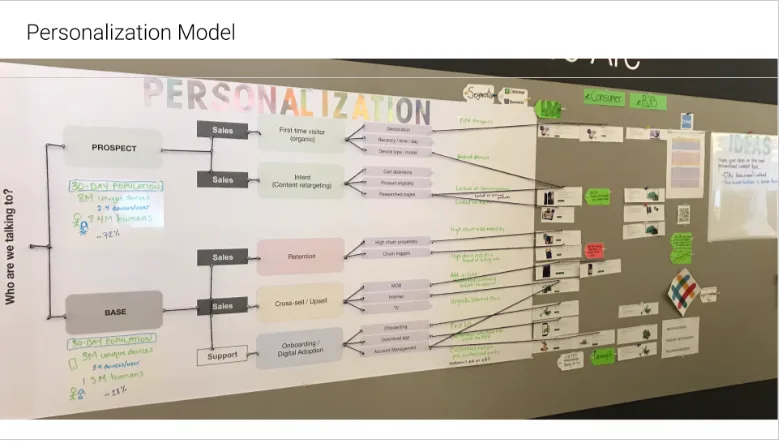Optimizing the End-to-End Customer Experience with Personalization and Content Strategy
Data Intelligence · Jun 7, 2018
What are you binge-watching on Netflix right now? This question has become a common one I’ve been hearing in numerous conversations. A 2014 survey even found that some 84% of trailing Millennials (37% over 68 years old) engage in binge-watching TV series. Looks like binge-watching is now a cross-generational hobby, a skill to put on your CV, and a conversation starter to cut through awkward silence breaks.
However, I can tell you that as one of 57 million Netflix members, I still feel like an individual on the platform. To me, that’s the secret to Netflix, it’s a personalized experience from top to bottom. When I’ve been scrolling for hours, trying to find that next best show with no luck, I end up browsing through the Top Picks for Anne section to see what Netflix selects for me. I appreciate the effort Netflix has gone through to personalize my homepage with movies and shows I might like to save me time. I’ve also never met another Anne younger than 50, and, like Anne of Green Gables, we both spell our name with an “e” on the end. So, it’s nice to see my name spelt right on a platform I feel I had some hand in creating.
Defining personalization
Personalization makes everyone feel like an individual, even if the product being marketed is the same. Essentially, it’s about serving the right content to the right person at the right time on the right platform. That’s a mouthful, but, in a nutshell, that’s personalization.
Now, let’s get TELUS specific. If I’m an Apple customer and never intend on buying an Android device, then I only want to see the latest deals on iPhones. Right? That makes sense. When I come to the TELUS homepage as an Apple customer, a shiny new iPhone X is what I’m looking for. I may see an always-on brand message or a “Why TELUS?” message, but I came to the site to buy an iPhone. The customer’s intent is crucial information for us. Why did you come to the TELUS homepage? The answer to this question is something we need to anticipate, always.
As a Content Manager with a focus on personalization, my job is to ensure that your desires and intents are met when you get to the homepage. If you want to see the best iPhone deal TELUS has to offer, I want to ensure that you:
See the best iPhone deal; and
See a message that speaks to you on a personal level (whether that’s friendly and fluffy or logical and to the point, engagement determines the winning message).
Ideally, the TELUS homepage becomes a personal dashboard of the latest deals and messages catering to you, allowing you to navigate the website with ease. And, if you aren’t a TELUS customer, the homepage becomes a place where you can learn more about TELUS as a brand and find out why switching to TELUS will benefit you or align with your values.
The personalization landscape
Let’s look at personalization from a macro level and expand our lens outside of TELUS for a minute. It’s clear that personalization is changing the way we speak to our customers. A study by Gartner in 2015, states that “[by] 2018, organizations that have fully invested in all types of personalization will outsell companies that have not by 20%.”
With this statistic in mind, in 2018, it’s no surprise to see personalization flooding the digital landscape. Finally, we’re starting to see businesses optimizing end-to-end customer experiences using personalization. And, as a customer, that means seeing more relevant content.
Innovators in the space such as the Netflix and Amazons of the world are recommending products and serving you content across the web that identifies that one item you can’t stop thinking about. The window shoppers are becoming buyers as their desired products begin appearing around the web, reminding them why they need that perfect _____. It’s becoming harder to run away from shopping carts that we fill and close after a moment of buyer’s guilt. These carts come back to us in emails with coupon codes to make that purchasing decision easier for us, and we cave every time (at least I do!).
Marketing is smarter, and personalization is changing the way we shop today.
At TELUS, our goal is to serve our customers the content they’re looking for. However, a lot goes into making this happen. Our personalization practice is setting ambitious goals so that we can achieve a complete personalized experience for our customers.
Making data-informed decisions using A/B testing

Our Personalization Wall at TELUS Digital
Using data to inform our decisions is a core value at TELUS Digital and guides our personalization practice. We might have an idea of what our customer’s interests are, but the data proves us right or wrong every time. We aim to make data-informed decisions across all of our teams and direct our strategy from the beginning.
In order to make data-informed decisions, our personalization practice uses A/B testing. In fact, “every product change Netflix considers goes through a rigorous A/B testing process before becoming the default customer experience.” At TELUS, we use the same approach to determine which personalized message or experience works best for what customer. Without A/B testing, our website would be subjective based on what we think the customer wants.
Using anonymized customer data, we are able to create personalized experiences. We can test different messages on our site and determine the content that creates the most engagement with our customers by using the data we collect to make these decisions. But, it’s not just about the content. We want to A/B test design, information architecture, content hierarchy, etc. All of these pieces create an experience for a new customer who has never visited TELUS—to a customer that’s been with TELUS for 10 years.
Every stakeholder has an opinion of what our customers want and need, but A/B testing takes the passion and opinion out of it and lets the data speak for itself. We hope to scale our testing practice so that we can create the best experiences for our audience, no matter what the journey may be.
Real-time customer segmentation

With our personalization framework, we can create segments linked to the current actions or past actions of our new and existing customers. We create our segments using key insights such as what device you’re using to browse the TELUS website or past clicks. With these insights, just like Netflix, we can begin creating personalized experiences tailoring to your interests. The more you engage with our website, the better we can understand what you’re looking for.
By using these unique attributes to define who our customers are and what they’re looking for, we can begin grouping our customers and creating niche segments. Next, we can begin writing content that suits each segment to ensure that every customer sees a personalized message. The more personalized the message, the more customer engagement we see.
Completing the journey with email marketing

Recently, we’ve connected all of our data to our email marketing platform, enabling the personalization practice to take strategy to the next level. This addition gives us the capability to send out a cart abandoner email the moment a customer has left TELUS without their new iPhone. It also allows us to share our data across the business, instead of personalizing just one point of the customer journey and keeping our practice siloed.
Now, the personalization possibilities are endless. From a customer’s first click on the homepage, we can send them a personalized email campaign, an SMS text, or cart abandoner offer. It’s the first step in taking all of the data we have to customize a complete personalized journey and serve the right offers at the right time.
Working in a massive organization like TELUS, consistency across departments, experiences, and opinions can be a challenge. By linking all of our data together, we can create an amazing experience for our customers, no matter what the challenges may be that exist behind the scenes.
Content strategy & personalization

More recently, TELUS Digital has introduced a Content Team to scale our personalization practice and craft the right messaging for a specific segment and experience.
What is content strategy?
Content strategy is no longer about clickbait, and it’s more than copywriting. It’s about:
Owning the end-to-end customer experience with user experience (UX) and user interface (UI) in mind;
Partnering with Design around overall page navigation and information architecture;
Defining the most important content, the content our customers should be seeing at the top of the page to the content that will encourage them to scroll to the bottom;
Making content accessible for all customers; and
Ensuring content is search-worthy, keeping SEO top of mind so that we serve our customers the content they’re searching for.
At TELUS, we want our content to be relevant to our customers by using A/B testing to determine the content that works best. And, ultimately, we want to personalize every experience so that our customers can navigate our website and find what they want to, easily.
Find out more about TELUS’ personalization journey at Adobe Symposium 2018 where we will be speaking about our work with Adobe in creating the best-personalized experiences for our customers.
Anne Booth is a Content Manager focusing on personalization and analytics at TELUS Digital. She is passionate about content strategy, SEO, A/B testing, Nutella, Netflix, and personalizing every customer experience. Her favourite comeback is: “I’m not saying that… the data is.”



